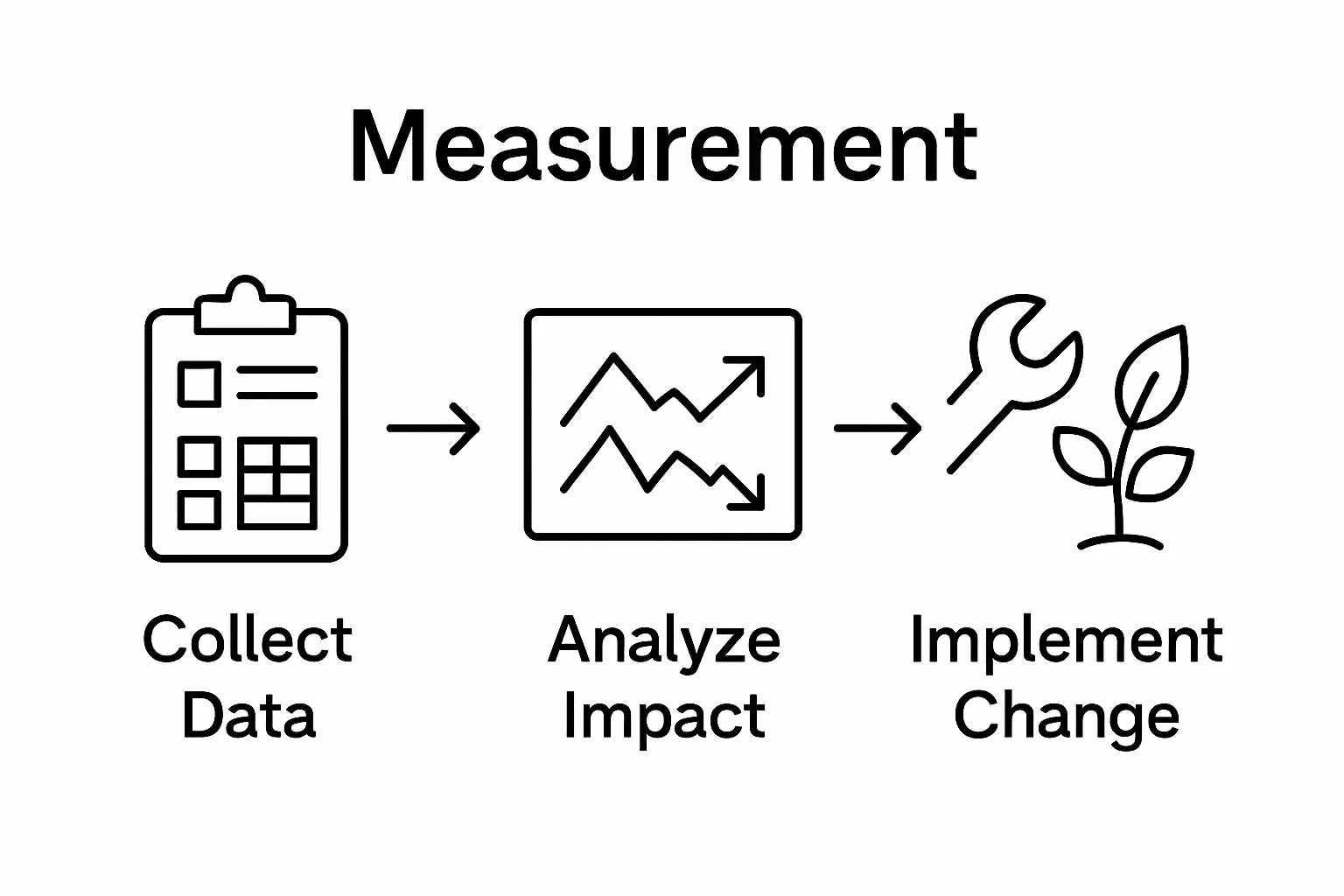How to Measure Environmental Impact in Your Business

Every business creates an environmental footprint, sometimes bigger than you might think. Some companies discover their operations produce waste volumes that can fill dozens of dumpsters each month or energy bills that rival small towns. Most owners expect measuring impact will be complicated and inaccessible, but the real surprise is how a few simple steps can reveal your footprint with clarity and set you on a path toward meaningful sustainability.
Table of Contents
- Step 1: Assess Current Environmental Practices
- Step 2: Identify Key Environmental Indicators
- Step 3: Collect Relevant Data From Operations
- Step 4: Analyze Data To Assess Impact
- Step 5: Implement Improvement Strategies
- Step 6: Monitor And Report On Progress
Quick Summary
| Key Point | Explanation |
|---|---|
| 1. Conduct a thorough environmental audit | Gather detailed data on resource consumption and waste to assess your current environmental practices accurately. |
| 2. Identify specific environmental indicators | Select measurable metrics that reflect your business’s unique environmental impact to guide performance tracking. |
| 3. Implement a structured data collection system | Use standardized protocols and digital tools for accurate, ongoing environmental data gathering across departments. |
| 4. Analyze data against industry benchmarks | Compare your environmental performance metrics with established standards to identify strengths and improvement opportunities. |
| 5. Develop actionable improvement strategies | Create a strategic roadmap prioritizing initiatives based on potential impact, costs, and alignment with business goals. |
Step 1: Assess Current Environmental Practices
Understanding your current environmental practices is the foundational step in measuring and reducing your business’s environmental impact. This initial assessment provides a clear baseline from which you can develop targeted strategies for sustainability and track meaningful progress.
Begin by conducting a comprehensive environmental audit that examines every aspect of your business operations. This process involves gathering detailed data about your current resource consumption, waste generation, energy usage, and overall carbon footprint. Start by collecting documentation from various departments including purchasing, facilities management, logistics, and production.
Key documentation to gather includes utility bills, waste management records, procurement reports, transportation logs, and any existing environmental compliance documents. Look for patterns of resource consumption and potential areas of inefficiency. Pay special attention to areas like energy usage, water consumption, material sourcing, and waste production.
Below is a checklist table outlining types of documentation and data you should collect when assessing your business’s current environmental impact. Use it to ensure thorough coverage during your initial audit.
| Documentation Type | Department/Source | Purpose |
|---|---|---|
| Utility bills | Facilities Management | Track energy and water consumption |
| Waste management records | Operations/Production | Measure waste volumes generated |
| Procurement reports | Purchasing | Review material sourcing and resource inputs |
| Transportation logs | Logistics | Assess emissions and fuel usage |
| Environmental compliance documents | Compliance/Legal | Confirm adherence to regulations |
| Production process data | Manufacturing/Production | Evaluate process efficiencies and environmental impacts |
Utilizing standardized assessment frameworks can significantly streamline this process. The International Organization for Standardization (ISO) provides comprehensive environmental management standards that offer structured approaches to environmental assessment. These frameworks help businesses systematically evaluate their current practices and identify improvement opportunities.
Consider engaging a professional environmental consultant who can provide an objective and thorough assessment. These experts bring specialized knowledge and can help identify nuanced aspects of environmental impact that internal teams might overlook. They can also recommend specific measurement tools and methodologies tailored to your industry and business size.
During your assessment, document everything meticulously. Create detailed spreadsheets that track current consumption levels, waste volumes, energy use, and other relevant metrics. This baseline data will be crucial for future comparisons and tracking your sustainability improvements.
The goal of this initial step is not just to collect data but to develop a comprehensive understanding of your current environmental footprint. By establishing a clear, detailed picture of your existing practices, you create a solid foundation for implementing meaningful environmental impact reduction strategies.
To help you plan your sustainability journey, here is a step overview summarizing each main stage in measuring your business’s environmental impact, along with key activities and expected outcomes.
| Step | Key Activities | Expected Outcome |
|---|---|---|
| Assess Current Environmental Practices | Conduct audits, gather utility bills, waste and procurement records | Establish baseline of environmental footprint |
| Identify Key Environmental Indicators | Select relevant metrics, map processes, develop measurement protocols | Define meaningful indicators tailored to business |
| Collect Relevant Data from Operations | Set up data systems, automate tracking, ensure data quality | Accurate, actionable environmental data |
| Analyze Data to Assess Impact | Compare with benchmarks, use visualization tools, qualitative review | Insights into strengths, weaknesses, opportunities |
| Implement Improvement Strategies | Prioritize actions, assign responsibilities, invest in technology | Launch impactful environmental initiatives |
| Monitor and Report on Progress | Build tracking dashboard, schedule reporting, verify data | Sustain transparency and drive continuous improvement |
Step 2: Identify Key Environmental Indicators
After completing your initial environmental assessment, the next critical step is identifying the specific environmental indicators that will provide meaningful insights into your business’s ecological impact. These indicators serve as precise measurements that help you understand and track your environmental performance across different operational dimensions.
Environmental indicators are quantifiable metrics that represent various aspects of your business’s interaction with the natural environment. They transform abstract environmental concepts into concrete, measurable data points that can guide strategic decision making. Think of these indicators as the vital signs of your organization’s environmental health.
The selection of these indicators should be strategic and tailored to your specific industry and business model. Some universal indicators include carbon emissions, water consumption, waste generation, energy efficiency, and resource utilization. However, the most effective indicators will be those that directly reflect your unique operational context.
The Carbon Disclosure Project provides comprehensive guidance for selecting meaningful environmental indicators that align with global reporting standards. Their frameworks help businesses understand which metrics are most relevant and impactful for their particular sector.
To develop your indicator set, start by mapping your business processes and identifying points of environmental interaction. Consider the entire lifecycle of your products or services, from raw material sourcing to final disposal. This holistic approach ensures you capture a comprehensive view of your environmental impact.
Quantitative precision is crucial when establishing these indicators. Develop clear, specific measurement protocols that allow for consistent and accurate data collection. This might involve installing specialized monitoring equipment, creating standardized reporting templates, or implementing digital tracking systems that can capture real time environmental performance data.
Remember that the goal is not just to collect data, but to generate actionable insights. Choose indicators that not only measure current performance but also provide clear pathways for potential improvement. Each selected indicator should offer meaningful information that can inform strategic environmental management decisions.
Successful indicator identification requires cross departmental collaboration. Engage teams from operations, procurement, facilities management, and sustainability to ensure a comprehensive and nuanced approach to environmental measurement. Their collective expertise will help you develop a robust and meaningful set of environmental indicators that truly reflect your organization’s ecological footprint.
Step 3: Collect Relevant Data from Operations
Data collection represents the critical bridge between identifying environmental indicators and understanding your actual operational impact. This step transforms abstract metrics into concrete insights that reveal the true ecological footprint of your business operations.
Begin by establishing a comprehensive data collection strategy that encompasses all relevant operational areas. Systematic and rigorous data gathering is essential for creating an accurate environmental assessment. This means developing standardized protocols for capturing information across different departments and operational zones.
Technology plays a pivotal role in modern environmental data collection. Digital tools and software platforms can automate much of the data gathering process, reducing human error and providing real time tracking capabilities. Consider investing in specialized environmental management software that can integrate data from multiple sources and generate comprehensive reports.
The World Resources Institute provides guidance on establishing robust environmental data collection methodologies that can help businesses develop reliable measurement systems. Their frameworks offer structured approaches to capturing and analyzing operational environmental data.
Focus on collecting granular information across key operational domains. This includes detailed records of energy consumption, water usage, waste generation, material procurement, transportation logistics, and production processes. Each data point should be timestamp tagged and include specific contextual information that allows for meaningful analysis.
Implement a centralized data management system that allows for consistent tracking and easy accessibility. This system should enable cross departmental collaboration, allowing teams from different areas of the business to contribute and access relevant environmental performance data. Ensure that data collection protocols are transparent and understood by all staff members involved in the process.
Quality control is paramount in data collection. Develop robust verification mechanisms that include regular audits, cross referencing multiple data sources, and implementing checks to identify potential recording errors. Create a culture of accountability where accuracy and completeness are prioritized.
Remember that data collection is an ongoing process. Establish regular intervals for data gathering typically monthly or quarterly depending on your business complexity. These consistent check ins will help you track environmental performance trends and identify areas for potential improvement.
Successful data collection transforms environmental measurement from a theoretical exercise into a practical management tool. By gathering comprehensive, accurate operational data, you create a solid foundation for developing meaningful sustainability strategies.

Step 4: Analyze Data to Assess Impact
Data analysis transforms raw environmental information into meaningful insights that reveal your business’s true ecological footprint. This critical step moves beyond simple data collection, helping you understand the deeper implications of your operational practices and their environmental consequences.
Comprehensive data analysis requires a multifaceted approach that goes beyond surface level measurements. Begin by utilizing advanced statistical techniques and data visualization tools that can help uncover complex patterns and relationships within your environmental performance data. These tools will help translate numerical information into clear, actionable insights.
Start by comparing your collected data against established industry benchmarks and environmental standards. This comparative analysis provides context, helping you understand how your business performance measures up to sector wide expectations. Look for areas of significant deviation, both positive and negative, that might indicate unique challenges or opportunities for improvement.
The Global Reporting Initiative offers comprehensive frameworks for interpreting environmental performance data that can guide your analysis process. Their methodologies provide structured approaches to understanding the broader implications of your environmental metrics.
Employ both quantitative and qualitative analysis techniques. While numerical data provides objective measurements, contextual information helps explain the underlying reasons for specific environmental impacts. Consider the broader operational, technological, and strategic factors that contribute to your current environmental performance.
Develop a systematic scoring or rating system that allows for consistent evaluation across different environmental indicators. This might involve creating a weighted scoring mechanism that reflects the relative importance of different environmental metrics to your specific business context. Such a system enables more nuanced and comprehensive impact assessment.
Critical to this analysis is identifying both areas of environmental strength and potential improvement opportunities. Look for patterns that reveal systemic inefficiencies, resource waste, or unexpected environmental burdens. Each identified area becomes a potential target for future sustainability initiatives.
Consider engaging external sustainability experts or environmental consultants who can provide an objective third party perspective on your data analysis. Their specialized expertise can help uncover insights that internal teams might overlook and provide benchmarking against industry best practices.
Remember that data analysis is not a one time event but an ongoing process. Develop a regular review cycle that allows for continuous monitoring and interpretation of your environmental performance data. This approach ensures that your understanding of environmental impact remains dynamic and responsive to changing operational conditions.
Step 5: Implement Improvement Strategies
Transforming environmental analysis into actionable strategies is the most critical phase of your sustainability journey. This step bridges the gap between understanding your environmental impact and creating meaningful, tangible improvements across your business operations.
Strategic implementation requires a holistic and systematic approach. Begin by prioritizing improvement opportunities based on their potential environmental impact, cost effectiveness, and alignment with your broader business objectives. Not all identified issues can or should be addressed simultaneously, so develop a strategic roadmap that creates a logical sequence of environmental interventions.
Start with low hanging fruit initiatives that can deliver quick wins and demonstrate immediate progress. These might include energy efficiency upgrades, waste reduction programs, or simple operational modifications that can be implemented with minimal disruption. Early successes build organizational momentum and create stakeholder buy in for more complex sustainability initiatives.
The United Nations Global Compact provides comprehensive guidance for developing corporate sustainability strategies that can help organizations create meaningful environmental improvement frameworks. Their resources offer structured approaches to translating environmental insights into practical actions.
Develop a cross functional implementation team that includes representatives from different departments. This ensures a comprehensive approach that considers operational, financial, and technological constraints. Assign clear responsibilities, establish specific timelines, and create accountability mechanisms that track progress and measure the effectiveness of each implemented strategy.
Technology and innovation will be crucial in driving environmental improvements. Investigate emerging technologies, sustainable alternatives, and innovative processes that can help reduce your environmental footprint. This might involve upgrading equipment, redesigning operational workflows, or adopting more sustainable procurement practices.
Create a robust monitoring and feedback system that allows for continuous assessment of implemented strategies. Regular performance reviews will help you understand the real world impact of your improvements and make necessary adjustments. Be prepared to iterate and refine your approach based on actual results and changing environmental conditions.
Financial considerations are critical in strategy implementation. Develop a clear business case for each proposed improvement that demonstrates both environmental benefits and potential cost savings or revenue opportunities. This approach helps secure leadership support and ensures that sustainability initiatives are viewed as strategic investments rather than mere expenses.
Remember that implementing improvement strategies is an ongoing process of continuous learning and adaptation. Maintain flexibility, encourage innovation, and create a organizational culture that views environmental sustainability as a dynamic, integral part of your business strategy.
Step 6: Monitor and Report on Progress
Monitoring and reporting represent the critical final stage in your environmental impact measurement journey, transforming collected data into meaningful narratives that demonstrate your organization’s commitment to sustainability. This step ensures transparency, accountability, and continuous improvement in your environmental management efforts.
Establishing a consistent monitoring framework is essential for tracking your environmental performance over time. Develop a comprehensive dashboard that captures key environmental indicators, allowing for real time tracking and comparative analysis. This system should provide clear visualizations that make complex environmental data accessible and understandable to both internal stakeholders and external audiences.
Create a reporting schedule that aligns with both internal strategic planning cycles and external reporting requirements. Quarterly and annual reports should provide detailed insights into your environmental performance, highlighting progress, challenges, and future improvement strategies. Consistency is key in building credibility and demonstrating long term commitment to environmental sustainability.
The Global Reporting Initiative offers standardized frameworks for comprehensive sustainability reporting that can help businesses communicate their environmental impact effectively. These internationally recognized standards provide structured approaches to transparent environmental communication.
Develop multiple reporting channels to reach different stakeholder groups. This might include detailed technical reports for environmental specialists, executive summaries for leadership, and more accessible infographics or storytelling formats for broader audiences. Each reporting format should maintain scientific rigor while remaining engaging and comprehensible.
Implement robust verification mechanisms to ensure the accuracy and reliability of your reported data. This may involve engaging third party auditors or sustainability experts who can provide independent assessment of your environmental performance metrics. External verification adds credibility and helps identify potential areas for improvement that internal teams might overlook.
Technology plays a crucial role in modern environmental monitoring. Invest in advanced data collection and reporting software that can automate much of the tracking process, provide real time insights, and generate comprehensive reports with minimal manual intervention. These tools can help reduce human error and provide more dynamic, responsive environmental management approaches.
Encourage a culture of transparency and continuous learning within your organization. Use reporting not just as a compliance exercise, but as an opportunity for reflection, innovation, and strategic planning. Each reporting cycle should inform future environmental improvement strategies, creating a dynamic, iterative approach to sustainability management.

Take Real Action on Your Business’s Environmental Impact With The Ocean Straw
You have learned how crucial it is to measure true environmental impact and how every detail from selecting indicators to implementing better solutions can shape your business’s footprint. If you are searching for ways to transform your assessment into practical results and lower your environmental score, your choice of everyday products speaks volumes. Wasteful single-use plastics and non-compostable materials remain a real pitfall for HoreCa businesses seeking to match their sustainability commitments with real-world practices.

Now is the time to commit to a smarter, greener approach. At The Ocean Straw, you can source truly plant-based and compostable straws that support your sustainability strategies without compromise. Ready to align your operations with your business goals? Explore our solutions right now at The Ocean Straw and join other HoreCa leaders who are making a measurable difference. Start reducing your business’s environmental footprint today—your next step to a more sustainable future begins here.
Frequently Asked Questions
How can I assess my business’s current environmental practices?
To assess your current environmental practices, begin by conducting a comprehensive environmental audit. Gather detailed data on resource consumption, waste generation, energy usage, and carbon footprint from various departments to establish a clear baseline of your practices.
What are key environmental indicators to track?
Key environmental indicators include carbon emissions, water consumption, waste generation, energy efficiency, and resource utilization. These metrics should be tailored to reflect your specific industry and operational context for meaningful insights.
How should I collect data for environmental impact measurement?
Develop a systematic data collection strategy that includes standardized protocols for gathering information across all relevant operational areas. Utilize digital tools for automation to improve accuracy and reduce human error in data gathering.
How do I analyze the data collected to assess environmental impact?
To analyze collected data, compare it against industry benchmarks and utilize advanced statistical techniques. Employ both quantitative and qualitative analysis to identify patterns, strengths, and opportunities for improvement in your environmental practices.